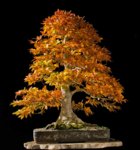I've grown and trained both European and Japanese beech for decades. European beech is more winter hardy in Upstate NY than the Japanese species. Most "Japanese" beech have larger foliage than the European beech. However, the common Japanese beech is not often trained in Japan. Rather they train the Fuji Japanese beech. They often forget to put the "Fuji" in the name. The Fuji Japanese beech generally come from the area surrounding Mt. Fuji. This variety has slender leaves, European beech has a wider leaf blade. The European beech foliage can easily be reduced, using common training techniques for beech foliage maintenance.
The European beech is much easier to find in the US than Japanese beech. And, this year European beech seedlings are in very short supply from large wholesale nurseries around the country. A few years ago we had the same problem because of seed crop failure.
I now grow and prefer European beech for bonsai. They quickly develop and make excellent forest, two specimens are attached.
For a comprehensive article on how to create a beech forest check out my blog:
https://valavanisbonsaiblog.com/2014/03/
Also, the World Bonsai Friendship Federation also reprinted the same article which can be seen here:
http://wbffbonsai.com/Education/Beech Forest.pdf
Last year we were able to get some fantastic larger European beech seedlings with branching. They are now established in 1 gallon pots and available in my seedling catalog here:
http://www.internationalbonsai.com/files/1708315/uploaded/2019 SEEDLING CATALOG.pdf
Have fun, I'll stick with European beech, unless I find some well branched Japanese beech specimens.
You know, certain plant names sound "exotic" and the sell by themselves like Brazilian Rain Tree, Japanese Beech and Ezo Spruce. Marketing is important.
View attachment 223060
European beech 2002
View attachment 223061
European beech 2003
View attachment 223062
European beech 2012
View attachment 223063
New European beech forest after creating in 2014 (same as in my blog post)
View attachment 223064
New European beech forest 2016
View attachment 223065
New European beech forest 2018. Not bad for only four seasons of development. Look at some of your trees and see what you can develop in only 4 years....








